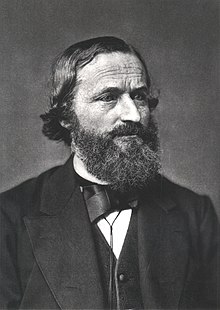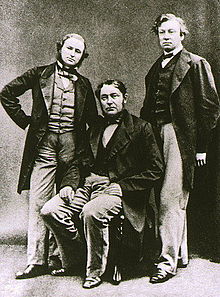Gustav Robert Kirchhoff

Gustav Robert Kirchhoff (born March 12, 1824 in Koenigsberg (Prussia) , † October 17, 1887 in Berlin ) was a German physicist who made a special contribution to research into electricity .
origin
His parents were the judge and district judge in Königsberg Carl Friedrich Kirchhoff and his wife Johanne Henriette Wittke . His brother Carl († 1893) was an imperial judge.
Life
Gustav Robert Kirchhoff studied mathematics and physics at the University of Königsberg from 1842 to 1847 under Franz Neumann and Friedrich Julius Richelot, among others . From 1850 to 1854 he worked at the University of Breslau , then moved to the University of Heidelberg (where he was prorector in 1865/66) and in 1875 came to the University of Berlin as a professor of theoretical physics . He held this position until 1886. In 1864 he was elected to the American Philosophical Society and in 1870 to the American Academy of Arts and Sciences . From 1861 he was a member of the Prussian Academy of Sciences . In 1862 he was accepted as a foreign member of the Göttingen Academy of Sciences and as a corresponding member of the Russian Academy of Sciences in Saint Petersburg . In 1868 he became an Honorary Fellow of the Royal Society of Edinburgh , in 1870 a corresponding member of the Académie des sciences in Paris and in 1875 a foreign member of the Royal Society , whose Rumford Medal (1862) and Davy Medal (1877) he received. In 1876 he received the Cothenius Medal of the Leopoldina , in 1883 he became a member of the National Academy of Sciences .
In 1857 he married Clara Richelot († 1869), a daughter of the Königsberg mathematician Friedrich Julius Richelot . With her, Kirchhoff had two sons and two daughters. The daughter Paula from this marriage was married to the geologist Wilhelm von Branca .
After the death of his first wife, he married Luise Brömmel in 1872, who was employed at the Heidelberg Eye Clinic. Kirchhoff's grave is located in the Old St. Matthew Cemetery in Berlin-Schöneberg . It has been dedicated to the city of Berlin as an honorary grave since 1956 .
Act
Kirchhoff is known for his rules of electrical circuits for describing the dependence of electrical voltage , electrical current and electrical resistance , which he found in 1845. These so-called Kirchhoff's rules are fundamental for the construction and analysis of electrical circuits and electrical engineering in general.
Kirchhoff discovered the elements cesium and rubidium in 1861 together with Robert Wilhelm Bunsen during the spectral analysis of the mineral water of the newly developed Maxquelle in Dürkheim . Their studies also made it possible to explain the Fraunhofer line and thus create one of the essential foundations of modern astronomy.
The Kirchhoff's radiation law states that matter of any kind sends a continuous heating radiation which is invisible or visible depending on the temperature. This radiation is called temperature or thermal radiation . An extensive experimental investigation of this law was initially out of the question, as the means for measuring high temperatures and low radiation energy were lacking. However, the far-reaching importance was immediately recognized. The resulting concept of the black body eventually led to quantum physics .
Kirchhoff also dealt with the plate theory ; the Piola-Kirchhoff stress tensor , the Kirchhoff-Love hypothesis and the so-called Kirchhoff plates remind of this.
Kirchhoff did not form a school, but through his role model he brought some physicists on the path, such as the Hungarian physicist and geophysicist Loránd Eötvös .
Honors
The lunar crater Kirchhoff and the asteroid (10358) Kirchhoff are named after him, as is the “Kirchhoff Institute for Physics” (KIP) at Heidelberg University . On February 15, 1974, the Deutsche Bundespost Berlin issued a special postage stamp ( MiNr. 465 ) on the occasion of his 150th birthday . In Berlin-Adlershof , Bad Dürkheim and Heidelberg a street bears his name.
Fonts (selection)
- Chemical analysis by spectral observations . In: Annals of Physics and Chemistry . Volume 110 (= 186), number 6, 1860, pp. 161-189 (with Robert Bunsen. Digital edition. Univ. Heidelberg, 2013).
- Chemical analysis by spectral observations. Second treatise . In: Annals of Physics and Chemistry . Volume 113 (= 189), number 7, 1861, pp. 337-381 (with Robert Bunsen. Gallica )
- About the goal of science . Vice-Rector's speech at the University of Heidelberg on November 22, 1865. ( Digital edition. Univ. Heidelberg, 2013)
- Collected Treatises . Johann Ambrosius Barth, Leipzig 1882 (edited by Ludwig Boltzmann).
- Collected Treatises. Addendum . Johann Ambrosius Barth, Leipzig 1891 (edited by Ludwig Boltzmann).
-
Lectures on mathematical physics . 4 volumes, BG Teubner, Leipzig 1876–1894.
- Volume 1: Mechanics . 1st edition, BG Teubner, Leipzig 1876 ( online ).
- Volume 2: Mathematical Optics . BG Teubner, Leipzig 1891 (edited by Kurt Hensel, online ).
- Volume 3: Electricity and Magnetism . BG Teubner, Leipzig 1891 (published by Max Planck, online ).
- Volume 4: Theory of Heat . BG Teubner, Leipzig 1894 (published by Max Planck, online (no longer available) ).
literature
- Biographies
- Walther Gerlach : Kirchhoff, Gustav Robert. In: New German Biography (NDB). Volume 11, Duncker & Humblot, Berlin 1977, ISBN 3-428-00192-3 , pp. 649-653 ( digitized version ).
- Klaus Hentschel : Gustav Robert Kirchhoff (1824–1887) and Robert Wilhelm Bunsen (1811–1899). In: Karl von Meyenn (Ed.) The Great Physicists. Munich: Beck, 1997, Vol. 1, pp. 416-430.
- Klaus Huebner: Gustav Robert Kirchhoff. The ordinary life of an extraordinary man. Regional culture publishing house, Ubstadt-Weiher 2010, ISBN 978-3-89735-606-1 .
- Robert Knott: Kirchhoff, Gustav Robert . In: Allgemeine Deutsche Biographie (ADB). Volume 51, Duncker & Humblot, Leipzig 1906, pp. 165-167.
- Karl-Eugen Kurrer : The History of the Theory of Structures. Searching for Equilibrium , Ernst & Sohn 2018, p. 1015 f (biography), ISBN 978-3-433-03229-9
- Contemporary memories
- Gustav Robert Kirchhoff. In: Ludwig Boltzmann : Popular writings. Johann Ambrosius Barth, Leipzig 1905, pp. 51–75 ( online , digital new edition. Univ. Heidelberg 2009 ).
- Woldemar Voigt : In memory of G. Kirchhoff. Speech given at the public meeting of the K. Society of Sciences on December 5, 1887 (= Treatises of the Royal Society of Sciences in Göttingen. Volume 35, Number 7). Dieterich, Göttingen 1888 ( online ).
- The essay by Friedrich Pockels (1865–1913) about Gustav Robert Kirchhoff appeared in “Heidelberg Professors from the 19th Century” -: Festschrift of the university on the centenary celebration of its renewal by Karl Friedrich. - Vol. 2, 1903, pp. 243-263
- In memory of Gustav Robert Kirchhoff . Articles by Robert v Helmholtz, August W. v. Hofmann, Friedrich Pockels and Emil Warburg. Univ. Heidelberg 2014
Individual evidence
- ↑ Klaus Huebner: Gustav Robert Kirchhoff - The ordinary life of an extraordinary man. Regional culture publishing house, Ubstadt-Weiher, 2010. ISBN 978-3-89735-606-1 .
- ↑ Member History: Gustav R. Kirchhoff. American Philosophical Society, accessed October 24, 2018 .
- ↑ Holger Krahnke: The members of the Academy of Sciences in Göttingen 1751-2001 (= Treatises of the Academy of Sciences in Göttingen, Philological-Historical Class. Volume 3, Vol. 246 = Treatises of the Academy of Sciences in Göttingen, Mathematical-Physical Class. Episode 3, vol. 50). Vandenhoeck & Ruprecht, Göttingen 2001, ISBN 3-525-82516-1 , p. 132.
- ^ Foreign members of the Russian Academy of Sciences since 1724. Gustav Robert Kirchhoff. Russian Academy of Sciences, accessed September 7, 2015 .
- ^ Fellows Directory. Biographical Index: Former RSE Fellows 1783–2002. (PDF file) Royal Society of Edinburgh, accessed December 27, 2019 .
- ^ Entry on Kirchhoff; Gustav Robert (1824-1887) in the Archives of the Royal Society , London
- ^ Winner of the Cothenius Medal Leopoldina from 1864–1953: 1876 Gustav Robert Kirchhoff, accessed on June 26, 2017.
- ↑ G. Kirchhoff, R. Bunsen: Chemical analysis through spectral observations . In: Annals of Physics and Chemistry . Volume 189, Number 7, 1861, pp. 337-381 ( doi: 10.1002 / andp.18611890702 ).
- ↑ Wolfgang U. Eckart , Klaus Hübner and Christine Nawa: Upswing in the natural sciences - Bunsen, Kirchhoff and Helmholtz , in: Heidelberg University, Leibniz Institute for Regional Geography, Peter Meusburger and Thomas Schuch, published on behalf of Rector Prof. Dr. Bernhard Eitel : Wissenschaftsatlas der Universität Heidelberg , Bibliotheca Palatina, Knittlingen 2011, p. 98. English translation: Wolfgang U. Eckart , Klaus Hübner, and Christine Nawa: The Rise of the Natural Sciences - Bunsen, Kirchhoff, and Helmholtz , in: Heidelberg University, Leibniz Institute for Regional Geography Leipzig, Peter Meusburger and Thomas Schuch (eds.) On behalf of Rector Bernhard Eitel : Wissenschaftsatlas of Heidelberg University , Bibliotheca Palatina, Knittlingen, 2012, p. 97.
Web links
- Literature by and about Gustav Robert Kirchhoff in the catalog of the German National Library
- CV ( LEIFI )
- John J. O'Connor, Edmund F. Robertson : Gustav Robert Kirchhoff. In: MacTutor History of Mathematics archive .
| personal data | |
|---|---|
| SURNAME | Kirchhoff, Gustav Robert |
| BRIEF DESCRIPTION | German physicist |
| DATE OF BIRTH | March 12, 1824 |
| PLACE OF BIRTH | Königsberg (Prussia) |
| DATE OF DEATH | October 17, 1887 |
| Place of death | Berlin |



